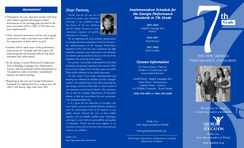Assessment
Throughout the year, classroom teachers will assess each student's growth and progress toward achievement of the learning goals specified in the state curriculum (GPS or QCC if GPS have not been implemented).
These classroom assessments will be used to guide instruction in order to provide every child with the opportunity to learn and to succeed.
Students will be made aware of the performance expectations for 7th grade and will acquire selfmonitoring and self-assessing skills to help them maximize their achievement.
In the spring, Criterion-Referenced Competency Tests in Reading, Language Arts, Mathematics, Science, and Social Studies will be administered to 7th graders in order to provide a standardized measure of student learning.
Beginning in the year the Georgia Performance Standards are implemented for a content area, the CRCT will directly align with those GPS.
Dear Parents,
Thank you for all you do as parents to guide your children's learning! I am confident that the future of all our children will be bright because of your continued support of public education in Georgia.
We are beginning the most extensive improvement in Georgia education undertaken in the last 18 years-- the implementation of the Georgia Performance Standards (GPS). The new state curriculum sets high standards, maintains clear expectations, and will place our schools and our students not just at the top of the Southeast, but at the top of the nation.
As a parent, I personally understand that this kind of change may generate questions and concerns: Why do we need a change? How will this impact my child? What will be different in my child's classroom?
For this reason, I have made communication and keeping you informed an absolute priority. Georgia's teachers and administrators have been preparing for this change, and they will be able to answer many of your questions at your local schools. I also encourage you to visit the Georgia Department of Education website to find out more about the new curriculum: www.georgiastandards.org.
It is a great day for education in Georgia. Like never before, our state is unified behind a mission to raise the achievement level of all students in our public schools. Toward this aim, we have rallied together and successfully tackled many challenges, ushering in a new level of accountability and quality in education. Thank you for your support as we continue to raise the bar for our state's most precious resource, our children.
Kathy Cox, State Superintendent of Schools
Implementation Schedule for the Georgia Performance Standards in 7th Grade
2005-2006 English Language Arts
Science 2006-2007 Mathematics 2007-2008 Social Studies
Contact Information
Dr. Eloise Barron, Director Division of Curriculum and
Instructional Services Gerald Boyd - English Language Arts
Claire Pierce - Mathematics Stephen Pruitt - Science
Dr. William Cranshaw - Social Studies (404) 656-4059 or (404) 656-2608
Kathy Cox, State Superintendent of Schools www.georgiastandards.org
The Georgia Department of Education is an Equal Opportunity Employer
7th Grade
THE NEW GEORGIA PERFORMANCE STANDARDS
We will lead the nation in improving student achievement.
Kathy Cox, State Superintendent of Schools
www.gadoe.org
7th Grade Language Arts
Seventh grade students will receive instruction in reading, writing, and listening, speaking, & viewing. By the end of 7th grade, students will be able to:
Use oral and written language, media, and technology for expressive, informational, argumentative, critical, and literary purposes
Discuss and analyze compelling works of literature
Constructively critique their own writing and the writing of their peers
Use descriptive words and complex sentences in a variety of writing genres
Proof their own writing and edit to conform to basic conventions of Standard English
Participate in oral presentations and dramatic interpretations for various audiences
Analyze the effects of media images, text, and sound on viewers
7th Grade Mathematics
All students will be actively engaged in developing mathematical understandings in real and relevant contexts. By the end of 7th grade, students will be able to:
Understand and use rational numbers, including signed numbers
Solve linear equations in one variable
Sketch and construct plane figures
Describe and sketch solid figures, including their cross sections, and examine properties of geometric shapes in space
Demonstrate understanding of transformations and apply properties of similarity
Represent and describe relationships between variables in tables, graphs, and formulas
Analyze the characteristics of linear relationships
Represent and analyze data using graphical displays, measures of central tendency, and measures of variation
Solve problems, communicate mathematically, reason and evaluate mathematical arguments, make connections among mathematical ideas and in other contexts, and represent mathematics in multiple ways
7th Grade Science
Seventh grade students will use inquiry, research, and investigation in life science to provide a smooth transition from elementary science to high school biology. By the end of 7th grade, students will be able to:
Collect, use, and analyze scientific data related to the diversity and classification of living organisms
Use the concepts of natural selection and fossil evidence in explanations
Recognize the basic characteristics of the major topics in life science such as the diversity of living organisms, the structure and function of cells, heredity, ecosystems, and biological evolution
Describe the structure and function of cells, tissues, organs, and organ systems
Examine the dependence of organisms on one another and on their environments
7th Grade Social Studies
Seventh grade students will study the history, geography, political structures, and economics of Africa and Asia. By the end of 7th grade, students will be able to:
Identify and explain significant historical developments leading to and of 20th & 21st century Africa and Asia
Describe the development of the three major religions that originated in the Middle East
Explain the impact of location, climate, physical characteristics, natural resources, and population size on these regions of the modern world
Describe the cultural characteristics of Africa and Asia
Describe the impact of governmental policies and individual behaviors on these regions of the modern world
Describe different economic systems and economic policies as they relate to these regions of the modern world
